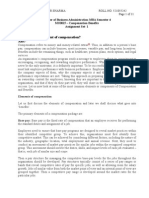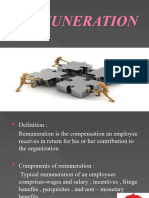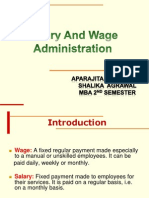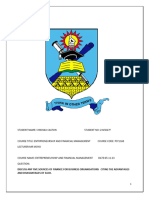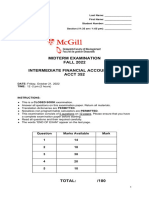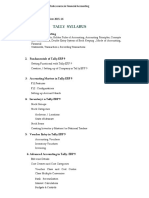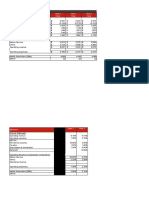Compensation Administration
Compensation Administration
Uploaded by
joybalentozaCopyright:
Available Formats
Compensation Administration
Compensation Administration
Uploaded by
joybalentozaOriginal Description:
Copyright
Available Formats
Share this document
Did you find this document useful?
Is this content inappropriate?
Copyright:
Available Formats
Compensation Administration
Compensation Administration
Uploaded by
joybalentozaCopyright:
Available Formats
1
Compensation
Pay structure within an organization
Is what employee receive in exchange for their contribution to the organization
Wage and Salary
- rate of pay of an employee
Incentives
- paid in addition to wages and salaries
Fringe benefits
- these include such employee benefits as provident fund, gravity, medical care,
hospitalization, accident relief, health and group insurance, canteen etc.
Perquisites
- offer to retain competent executives
Objectives of Compensation
attract suitable staff
retain qualified personnel
develop reward structures that are equitable with consistent and fair pay relationships
between differently valued jobs
Page | 1
adjust pay structures to reflect inflationary effects
ensure that rewards and salary costs adjust to changes in market rates or organizational
change
reward performance, responsibility, and loyalty, and provide for progression and
increases
keep compensation levels and differentials under review and control salary/wage costs
REPORTED BY:
Amigo, Jomalyn
Bacolongan, Mark Gelo
PAGE 1-2
Page | 2
Wage
It is a monetary compensation or remuneration paid by an employer to an employee in
exchange for work done
Payment may be calculated as a fixed amount for each task completed or at an hourly or
daily rate, or based on an easily measured quantity of work done.
Importance of Wage
One of the most important aspects of a job for most workers is the wage it pays. Wages
allow workers to make a living from their labor.
Also provide incentives to be productive and loyal to an employer.
In a broader sense, the wages workers earn fuel of the economy.
Income
For workers, wages are a primary source of income, along with smaller sources
like government aid and investment income. Wages from work pay for essentials. Such
as rent, a mortgage, food and utility bills. Workers who earn high wages can afford more
expensive lifestyles than those who earn lower wage. Minimum wage laws ensure that all
workers earn enough to pay for the basics, and that employer cant take advantage of
workers.
Page | 3
Retention
To employers, wages are an important tool for retaining workers. Low wages will
save money on payroll, but a more competitive wage will give workers fewer reasons to
leave for job elsewhere. Wages provide a means of reward, such as when an employer
gives a raise based on a performance evaluation, or issues a performance bonus.
Employees who earn a reasonable wage are more likely to fell valued by an employer,
which means that wages also contribute to workplace morale.
Spending Power
Wages play a major role in the economy by giving workers spending powers. This
refers not only to the money workers earn that they spend on necessities, but also the
money they save or use in the short term for consumer goods, recreation, travel, and
investing. Workers wages create jobs elsewhere by supporting manufacturers, retailers,
service providers and financial institutions that help workers manage their wealth.
Taxes
Wages are also a source of tax revenue for government. The more workers earn,
the higher their taxable income and tax rate. Unemployed taxpayers must claim their
unemployment benefits as income, but the limits on unemployment benefits mean that
unemployed individuals pay less in state and federal taxes than those who earn steady
wage. Higher wages, as occur in competitive industries where workers are in high
demand, boost government revenue and provide more funding for services and new
projects.
Page | 4
Kinds of Wages
1. Nominal Wages
Nominal wages are written down in contracts between the employee and the
organization.
2. Real Wages
Real wages somehow correct nominal wages for prices of good and services
bought by the employee.
In specific institutional settings, nominal wages may be automatically and
frequently adjusted to certain inflation measures, resulting in a more or less constant real
wages.
Types of Wages
1. Subsistence Wage
The wage that can meet only bare physical needs of a worker and his family is called
subsistence wage.
2. Minimum Wage
The wage that is able to provide not only for bare physical needs but also for
preservation of efficiency of worker plus some measure of education health and other things.
Page | 5
3. Fair Wage
It is an adjustable step that moves up according to capacity of the industry to pay, and
the prevailing rates of wages in the area of industry.
4. Living Wage
Living wage is that which workers can maintain the health and decency, a measure of
comfort and some insurance against the more important misfortune of life.
How to Calculate Wages
Wages are the number of hours worked multiplied by the hourly rate. The term wage is
another word for the terms salary or pay.
Know how the wage is calculated
A persons weekly wage is equal to the number hours worked multiplied by the hourly rate.
Example:
Hourly Rate x Hours = Wages
$6.00
20
= $120.00
Estimate a persons annual wages by multiplying the number of hours worked in a week
by 50 weeks.
It is easier and usually more accurate to use 50 weeks instead of 52 weeks. This will account
for any unpaid vacations and absences. A person who regularly works for 40 hours a week works
2,000 hours in a year.
Page | 6
Example:
Hours in a week x number of weeks = hours work in a year
40 hours/week x 50 weeks = 2000 hours
To estimate annual wages, use the hours worked in a year and multiply that by the hourly
rate.
Its the last step to finish wages calculation
Example:
Hours worked in a year x Hourly rate = Annual Wages
2000 hours/year x
$6.00
= $12000 Annual Wage
REPORTED BY:
Balentoza, Marie Joy
Balbuena, Alyssa Nicole
PAGE 3-7
Page | 7
Subsistence Theory by David Ricardo (1772-1823)
was based on the population theory of Thomas Malthus.
Also called as Iron Law of Wages
This theory states that The laborers are paid to enable them to subsist & perpetuate the
race without increase or diminution
Disadvantage or Criticism
No direct relationship between wage level and population
Wages FUND Theory by Adam Smith (1723-1790)
This theory states that wage level is determined by wage fund and the number of
workers employed.
The wage level is given by the ratio of wage fund and number of workers employed.
Mathematically,
Disadvantage or Criticism
Wage paid to workers differs from place to place, time to time, person to person and
organization to organization.
Page | 8
Surplus Value Theory of Wages by Karl Marks (1818-1883)
This theory states that Labor is the sole source of the economic value and therefore labor
should exercise the prime claim in revenue
Advantage
the income produced by a particular source should be paid to the labor.
Disadvantage or Criticism
Exploitation
Residual Claimant Theory by Francis A. Walker (1840-1897)
This theory states that wages are nothing but the residue of total revenues after
deducting all other legitimate expenses such as rent, taxes, interest and profits.
4 factor of production
land, labor, capital & entrepreneurship
Wages = value of production (rent+ interest+ profit)
Disadvantage or Criticism
Demand & supply factor ignored
Productivity & efficiency ignored.
Page | 9
10
Marginal Productivity Theory by Phillips Henry Wicksteed and John Bates Clark
This theory states that Wages are based on entrepreneurs estimate of the value that will
be produced by the last or marginal worker
Advantage
Full EMPLOYMENT of resources
Perfect competition
Perfect mobility of factor of production
Disadvantage or Criticism
No importance to supply of labor
In practice EMPLOYER gives lower wages than marginal productivity of laborer
Unrealistic assumptions
Bargaining Theory of Wages by John Davidson
This theory states that Wages are determined by relative bargaining power of workers or
trade unions and of the EMPLOYERS.
REPORTED BY:
Arizo, Remy
Cabuhat, Mia Raven
PAGE 8-10
Page | 10
11
Incentives are rewards relating to certain goals. Perks are benefits on top of basic salary.
Incentives and perks can be financial or non-financial. You can also have individual and group or
team incentives.
The benefits of staff incentive schemes
Incentives - such as performance-related bonuses - can help boost staff performance. The
rewards usually relate to the achievement of certain goals, either personal, team or
organizational, or a combination of all of these.
Perks are benefits given in addition to salary as a means of increasing satisfaction at work.
Pay is often the most important staff motivator and incentives and perks must not be seen as a
substitute for a good pay scheme. Incentives and perks do not have to be expensive for business
and some are even tax free.
Benefits to the business
An effective system of incentives could help:
persuade staff to join your business
retain existing staff
increase staff motivation, morale and loyalty
boost productivity
link individual and business performance
focus employees on achieving targets
build teamwork
Page | 11
12
Benefits to staff
Perks and incentives can form an attractive element of an employment package by:
enhancing the quality of working life
rewarding staff efforts
adding value to the employment contract
What makes effective schemes?
Incentives and perks must be affordable, transparent and appropriate to your business and
the jobs they link to It is worth consulting with staff or unions before introducing incentives and
perks. They work best alongside good pay schemes and working conditions and can be most
successful when implemented with other good management practices, such as performance
management, appraisals and appropriate communication and training programs.
Incentive schemes and the options
There is a wide range of incentive schemes, each with different costs. They include financial and
non-financial schemes, individual and group schemes, and short-term and long-term
schemes.
The options
Financial incentives can help improve performance and be self-financing.
Page | 12
13
Examples include:
profit-related and share option schemes
bonuses
commission
Non-financial and non-pay incentives include:
formal recognition/awards
vouchers
extra holidays
gifts
company cars
Advantages and disadvantages of incentive schemes
Incentive
Advantages
disadvantages
Can focus employees on hitting
Rewards are sometimes small
Financial
a target
Can demoralise if not earned
Places a value on achievement
Can recognise employee
Nonfinancial
priorities and lifestyles
Can be taken for granted
Can encourage attachment to
May be inappropriate
business
Page | 13
14
Incentive
Advantages
disadvantages
Can focus the individual on
Can be divisive
achievement
Individual
Individual earnings can
Links extra pay with extra
fluctuate
output
Can undervalue individual
Can encourage team working
skills
Group
Can correct individual underMay encourage bullying of
performance
under-performers
Promotion and training opportunities are not strictly incentives as they are ways of fulfilling
business needs.
Negative incentives, eg threat of dismissal, may work in the short term but can decrease morale
and loyalty.
Perks and the options
Perks are generally a good method of attracting and retaining employees as they are not related
to productivity. Perks can encourage staff attachment to the business.
Page | 14
15
The options
There are a wide range of perks, including:
occupational pensions
more holidays than the statutory minimum - see our guide on how to know how much
holiday to give your staff
gifts, eg on birthdays
health benefits, eg health insurance/assessments
flexible working - see our guide on flexible working - the law and best practice
subsidised staff canteens, tea/coffee-making facilities or goods/services
loans, eg season tickets
social events, eg Christmas parties and work outings
membership of social clubs
extra training, which goes beyond skills needed for the job
Tax
Most perks with an equivalent cash value have tax implications. See our section on expenses
and benefits for employers.
Other considerations
You may want to consider the following points when providing perks:
they must be perceived as worthwhile
they must not cost the employer more to provide than the employee could get them for
Page | 15
16
they must be worth more to the employee than any tax they will pay on them
Make sure that the perks you choose are relevant to both your business and staff. Be careful
when removing or changing any of the perks you offer. If they are part of your employees'
contracts you will need to gain their consent. If you do not get consent the employee may be
entitled to sue for breach of contract or resign and claim constructive dismissal. See our guide on
how to change an employee's terms of employment.
Steps to setting up an incentive scheme
Identify the scheme's objectives
Consult with staff and trade unions.
Relate the scheme to the business' remuneration system.
Establish any tax implications for your staff
Ensure that the planned scheme is competitive.
Decide on performance measures for your staff. .
Regularly review your scheme and obtain feedback.
Ensuring the incentive scheme is successful
1. Back your incentive programs with sound strategy
2. Let top performers pull everyone up.
3. Be sure everyone knows what their goals are.
4. Spell out what will be measured
5. Acknowledge discretionary effort
Page | 16
17
6. Make sure you're incentivizing the right behaviors.
7. Meet both organizational and individual needs
8. Use a mix of incentives
9. Establish the frequency of incentive distribution.
10. Bottom line, keep incentive programs simple.
REPORTED BY:
Balsamo, Stephanie Rac
Bugnon, Jerisha Iris
PAGE 11-17
Page | 17
18
WRITTEN REPORT
Compensation Administration
GROUP 1
Arizo, Remy
Amigo, Jomalyn
Bacolongan, Mark Gelo
Balentoza, Marie Joy
Balbuena, Alyssa Nicole
Balsamo, Stephanie Rac
Bugnon, Jerisha Iris
Cabuhat, Mia Raven
BSBA-HRDM 2-5D
Tuesday and Friday
9:00-10:30 A.M.
Page | 18
19
Amigo, Jomalyn
Bacolongan, Mark Gelo
INTRODUCTION OF COMPENSATION ADMINISTRATION
Balentoza, Marie Joy
Balbuena, Alyssa Nicole
WAGES AND THEIR SIGNIFICANCE
Arizo, Remy
Cabuhat, Mia Raven
THEORIES OF WAGES
Balsamo, Stephanie Rac
Bugnon, Jerisha Iris
INCENTIVES SCHEME
Page | 19
You might also like
- Wage and Salary AdministrationDocument34 pagesWage and Salary AdministrationSAVI100% (2)
- 4 TH unitHRMDocument5 pages4 TH unitHRMFitha FathimaNo ratings yet
- Answer:: Human Resource Management SET-2Document39 pagesAnswer:: Human Resource Management SET-2manasdas60No ratings yet
- PKSDocument11 pagesPKSPankaj SharmaNo ratings yet
- STIHRM MODULE 7Document3 pagesSTIHRM MODULE 7Joyce Ann ArsenioNo ratings yet
- Objectives of Compensation PlanningDocument5 pagesObjectives of Compensation PlanningPoonam SatapathyNo ratings yet
- Compensation & BenefitsDocument11 pagesCompensation & BenefitsStatistical DepartmentNo ratings yet
- MGL Comp - Intro-4Document24 pagesMGL Comp - Intro-4Ehtesam khanNo ratings yet
- CompensationDocument3 pagesCompensationmsaqib14uNo ratings yet
- Module 1 Compensation N RewardDocument52 pagesModule 1 Compensation N RewardAnshul PandeyNo ratings yet
- Compensation Management: ObjectivesDocument23 pagesCompensation Management: Objectivesanusmayavbs1No ratings yet
- Factors Affecting CompensationDocument13 pagesFactors Affecting Compensationkal200775100% (1)
- Compensation' in Other Terms Also Called As Employee Remuneration'Document13 pagesCompensation' in Other Terms Also Called As Employee Remuneration'Poonam MehanNo ratings yet
- Lesson-4Document21 pagesLesson-4Jessua Delos Santos BarsagaNo ratings yet
- Pay and Service ConditionsDocument12 pagesPay and Service Conditionsifuture2047No ratings yet
- Compensation Management MBA HRDocument67 pagesCompensation Management MBA HRAmardeep Upadhyay88% (25)
- Wages and Salary Administration PDFDocument4 pagesWages and Salary Administration PDFSaurabh M. Sale100% (1)
- Com Ad Module 2Document10 pagesCom Ad Module 2Gary AlaurinNo ratings yet
- HRM Unit 4 Wage N SalaryDocument30 pagesHRM Unit 4 Wage N SalaryAsmit ShuklaNo ratings yet
- CH 5Document57 pagesCH 5Micky TrầnNo ratings yet
- Vaishnavi 1Document7 pagesVaishnavi 1Ritesh SinghNo ratings yet
- Ch1 - Foundation On CompensationDocument5 pagesCh1 - Foundation On CompensationgagraduatethissemNo ratings yet
- Master of Business Administration - Mba Semester I (Fall 2010) Subject Code - MB0043 Subject Name - Human Resource Management Assignment Set - 2 (60 Marks)Document12 pagesMaster of Business Administration - Mba Semester I (Fall 2010) Subject Code - MB0043 Subject Name - Human Resource Management Assignment Set - 2 (60 Marks)Sreejith KarunakaranpillaiNo ratings yet
- bch513 CompensationDocument45 pagesbch513 CompensationDr.Shaifali GargNo ratings yet
- Meaning of Wage/Compensation Payment:: Chapter-1 Compensation Management-IDocument22 pagesMeaning of Wage/Compensation Payment:: Chapter-1 Compensation Management-IRamit GuptaNo ratings yet
- Wage and Salary AdministrationDocument7 pagesWage and Salary Administration13 Karthick.VNo ratings yet
- Acts Influence Compensation StructureDocument6 pagesActs Influence Compensation StructureCyrus FernzNo ratings yet
- Compensation Management: Performance and Reward Management Kmbnhr04Document19 pagesCompensation Management: Performance and Reward Management Kmbnhr04Haris AnsariNo ratings yet
- CPM Unit - IDocument11 pagesCPM Unit - Imba departmentNo ratings yet
- Lesson-4 CONTEMPORARY WORLDDocument19 pagesLesson-4 CONTEMPORARY WORLDMicaella JanNo ratings yet
- Salary Vs Wages Vs StipendDocument3 pagesSalary Vs Wages Vs Stipendvraj mishraNo ratings yet
- Compensation PlanningDocument49 pagesCompensation PlanningAkshay Kr TalrejaNo ratings yet
- Compensation ManagementDocument9 pagesCompensation Managementhamza77327No ratings yet
- Workers' CompensationDocument28 pagesWorkers' Compensationsinghvikanika7No ratings yet
- Wage and Salary AdministrationDocument7 pagesWage and Salary AdministrationInfo TechNo ratings yet
- Compensation' in Other Terms Also Called As Employee Remuneration'Document16 pagesCompensation' in Other Terms Also Called As Employee Remuneration'abhijeetkasliwalNo ratings yet
- Compensation ManagementDocument212 pagesCompensation ManagementSyed Adil Hussain100% (1)
- Remuneration 1Document17 pagesRemuneration 1Pavithra JNo ratings yet
- Compensation DefinitionDocument6 pagesCompensation DefinitionshorifmrhNo ratings yet
- Group 4 HRMDocument18 pagesGroup 4 HRMMary Jean C. DedilNo ratings yet
- RCM - Unit 1Document41 pagesRCM - Unit 1Vasugi KumarNo ratings yet
- CH 7Document5 pagesCH 7hailu mekonenNo ratings yet
- CH 17 Compensation ManagementDocument7 pagesCH 17 Compensation ManagementMD. AL HossainNo ratings yet
- Compensation ManagementDocument12 pagesCompensation Managementrithikapallewar1No ratings yet
- Compensation N BenfitsDocument52 pagesCompensation N BenfitsShalaka MohiteNo ratings yet
- Definition of Important TermsDocument9 pagesDefinition of Important TermsReimon DoblonNo ratings yet
- Unit-IV HRMDocument10 pagesUnit-IV HRMSaini Lakhvindar singhNo ratings yet
- Submitted in Partial Fulfillment of The Requirement For The Award of The Degree ofDocument60 pagesSubmitted in Partial Fulfillment of The Requirement For The Award of The Degree ofUday GowdaNo ratings yet
- Compensation Management HRMDocument31 pagesCompensation Management HRMVivek Singh0% (1)
- CHAPTER 1_ FOUNDATION OF COMPENSATION ADMINISTRATIONDocument6 pagesCHAPTER 1_ FOUNDATION OF COMPENSATION ADMINISTRATIONMary Rose JuanNo ratings yet
- Compensation ManagementDocument95 pagesCompensation Managementharikaviswanatham100% (1)
- Com Notes 3rd UnitDocument50 pagesCom Notes 3rd UnitVijaya Bhanu MouriceNo ratings yet
- Wage and Salary AdministrationDocument12 pagesWage and Salary AdministrationVijaya Bhanu MouriceNo ratings yet
- Salary and Wage AdministrationDocument35 pagesSalary and Wage AdministrationShalika Agrawal100% (2)
- Zanzibar University: Institute of Postgraduate Studies and Research Master of Business AdministrationDocument8 pagesZanzibar University: Institute of Postgraduate Studies and Research Master of Business AdministrationHaji MohamedNo ratings yet
- 04 - Chapter 1Document27 pages04 - Chapter 1kafi70156No ratings yet
- Compensation ManagementDocument12 pagesCompensation Managementprakhyasingh1905No ratings yet
- Compensation Management 1Document30 pagesCompensation Management 1myko7No ratings yet
- Maximizing Your Wealth: A Comprehensive Guide to Understanding Gross and Net SalaryFrom EverandMaximizing Your Wealth: A Comprehensive Guide to Understanding Gross and Net SalaryNo ratings yet
- General Awareness PDFDocument610 pagesGeneral Awareness PDFRamkumar NatarajanNo ratings yet
- SBR Int Syllabusandstudyguide Sept23 June24Document20 pagesSBR Int Syllabusandstudyguide Sept23 June24rsubediaccastudentNo ratings yet
- Chapter 4 Forms of Business OrganizationDocument6 pagesChapter 4 Forms of Business Organizationhey cuteNo ratings yet
- Discuss Five Sources FinanceDocument6 pagesDiscuss Five Sources Financen02315027fNo ratings yet
- Week 9: Chapter 8 Assignment: Dinh Thu Huong (1540312) BUS 3382Document2 pagesWeek 9: Chapter 8 Assignment: Dinh Thu Huong (1540312) BUS 3382san hanNo ratings yet
- Nasdaq Trading Strategy Wealth CreationDocument22 pagesNasdaq Trading Strategy Wealth CreationThembokuhle100% (1)
- 2023-Vol-1-Ch-3-Problems-Ans 3Document12 pages2023-Vol-1-Ch-3-Problems-Ans 3Glen ValdezcoNo ratings yet
- Ocm India Ltd.Document31 pagesOcm India Ltd.rimpyanitaNo ratings yet
- ACCT 352 Fall 2022 Midterm BlankDocument12 pagesACCT 352 Fall 2022 Midterm Blankannika.schmunkNo ratings yet
- In Gold We Trust 2017 Compact Version English.01Document29 pagesIn Gold We Trust 2017 Compact Version English.01Zerohedge100% (1)
- Description Amount Description Amount Description Amount Description AmountDocument1 pageDescription Amount Description Amount Description Amount Description Amountdell40235No ratings yet
- M2A1 US Census Data SearchDocument6 pagesM2A1 US Census Data SearchragcajunNo ratings yet
- Jarislowsky Fraser International Equity Segregated FundDocument1 pageJarislowsky Fraser International Equity Segregated Fundarrow1714445dongxinNo ratings yet
- ALC Investing in Renewable Energies Jan 2015Document14 pagesALC Investing in Renewable Energies Jan 2015HanyNo ratings yet
- Fabm1 Grade-11 Qtr4 Module2 Week-2Document6 pagesFabm1 Grade-11 Qtr4 Module2 Week-2Crestina Chu BagsitNo ratings yet
- Audit of Charitable InstitutionsDocument3 pagesAudit of Charitable Institutionsyogitabhootra99No ratings yet
- 3PO1 U1L2 PreTest Q6 - General Principles of Taxation - Tax LawsDocument1 page3PO1 U1L2 PreTest Q6 - General Principles of Taxation - Tax LawsKimberly MartinezNo ratings yet
- TDS On Payments To Non-Residents & Residents: Nihar Jambusaria, Bdo India 11 August, 2010Document45 pagesTDS On Payments To Non-Residents & Residents: Nihar Jambusaria, Bdo India 11 August, 2010rohit7853No ratings yet
- Tradebulls Securities (P) Limited Tradebulls Commodities Broking (P) LimitedDocument16 pagesTradebulls Securities (P) Limited Tradebulls Commodities Broking (P) LimitedKedar UkidveNo ratings yet
- TREASURER'S AFFIDAVIT - IncreaseDocument2 pagesTREASURER'S AFFIDAVIT - IncreaseFernando GapuzNo ratings yet
- Bank Liquidity Risk and Capital Structure: A Conceptual Review of Theoretical and Empirical Research On Islamic Banking PerspectiveDocument16 pagesBank Liquidity Risk and Capital Structure: A Conceptual Review of Theoretical and Empirical Research On Islamic Banking PerspectiveAmeliaNo ratings yet
- Asset and Liability ManagementDocument8 pagesAsset and Liability ManagementPriyanka YadavNo ratings yet
- Samsung Soundbar InvoiceDocument1 pageSamsung Soundbar InvoiceJeevan NJNo ratings yet
- Indemnity Letter to Reissue Duplicate FDR-ICICIDocument2 pagesIndemnity Letter to Reissue Duplicate FDR-ICICINarayanNo ratings yet
- March2013 PDFDocument124 pagesMarch2013 PDFlifesstudentNo ratings yet
- Applying APV in The Real World - The RJR Nabisco BuyoutDocument2 pagesApplying APV in The Real World - The RJR Nabisco Buyoutsulaimani keedaNo ratings yet
- Because The Expected Relevant Benefits ofDocument2 pagesBecause The Expected Relevant Benefits ofElliot RichardNo ratings yet
- Tally Syllabus: 1. Basics of AccountingDocument4 pagesTally Syllabus: 1. Basics of AccountingijrailNo ratings yet
- BCG Forage Core Strategy - Telco (Task 2 Additional Data)Document11 pagesBCG Forage Core Strategy - Telco (Task 2 Additional Data)Fadil JauhariNo ratings yet
- Biz Ethics PPT 1Document41 pagesBiz Ethics PPT 1Anjana BaruahNo ratings yet



